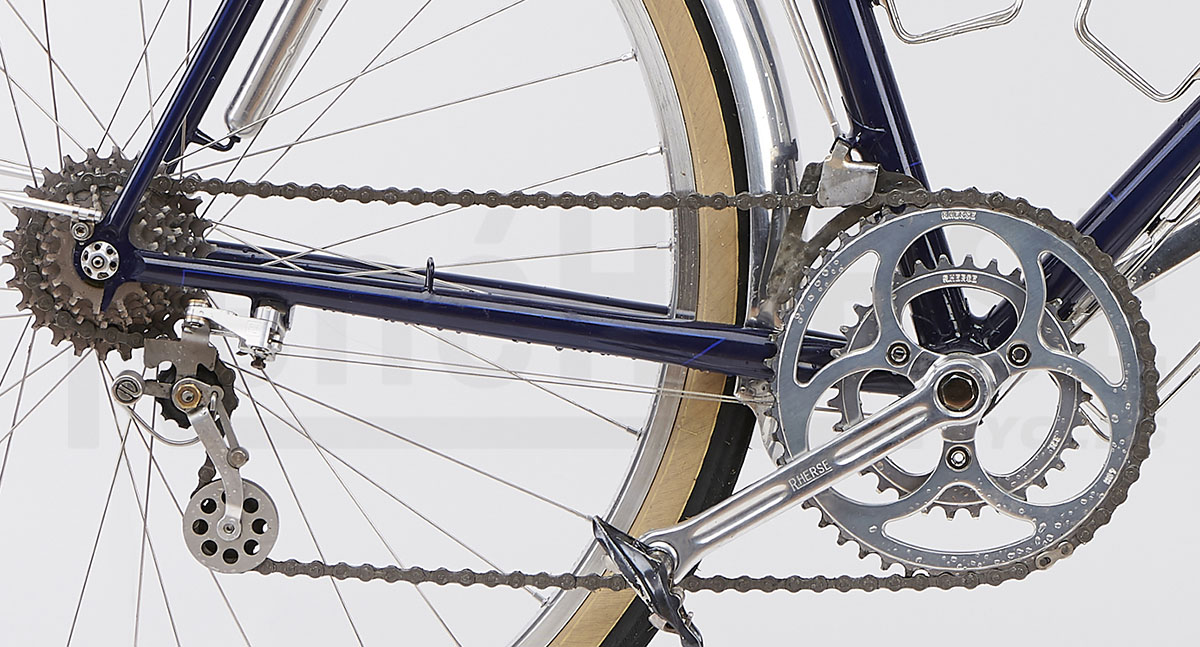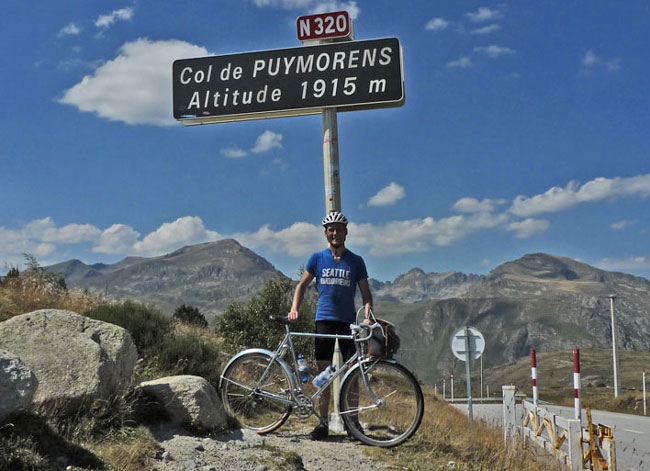My PBP Bike: Derailleurs
Why would anyone make custom derailleurs when modern electronic shifting works extremely well? It’s a bit like driving a car with manual transmission even though the latest automatics are very sophisticated. It’s about being involved in the operation of my bike, rather than just pushing a button. There’s a joy in feeling the gears engage perfectly because I – and not a computer – timed the shift perfectly.
There’s another aspect that’s at least as important for me: shift times. Modern derailleurs are optimized for shifting under load. That can be useful when you climb out of the saddle and want to shift, but it has a downside: To ensure smooth shifts, the derailleurs are designed to delay the shift until the ramps and pins of the cassette cogs and chainrings are aligned perfectly. How long that takes depends on the initial position of the cogs, so the lag between when I push the button and when the derailleur shifts isn’t consistent.
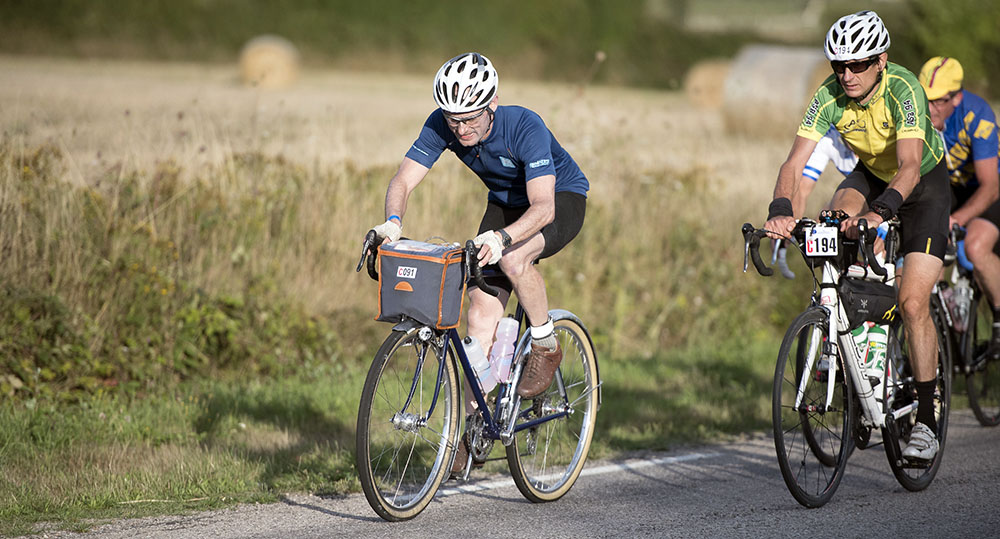
I usually climb seated, and I tend to let up on the pedals for a split-second during shifts anyhow. That is easy if the shift is immediate, but with modern systems, I’m often already back on the power when the shift finally happens. And then I get a crunch, because even the best systems don’t shift that well with very high power outputs. It’s not a big deal, but given a choice, I prefer a derailleur that shifts when I pull the lever – immediately and without delay.
When sports cars switched from manual to automatic transmissions, shift times were a big deal. Manufacturers worked hard to speed up the shifts until they were measured in milliseconds. These days, there’s a choice: A Mercedes S-Class shifts so smoothly that you don’t notice the shift, while a Ferrari shifts without any lag at all. (Or so I am told; I have to admit never having driven an S-Class nor a Ferrari.) And you can still get a Porsche with manual transmission, too. Bike components all seem to be designed like the S-Class, and I’m still waiting for a discussion of shift times.
I also don’t like charging batteries, but cable-operated brifters aren’t really a good choice for me. Most require more force to operate than I’d like. Lael Wilcox tells the story of losing a fingernail after pushing the shift lever so hard so many times during the Trans Am, and I’ve met riders in the final stages of Paris-Brest-Paris who no longer had the strength to push their Ergopower buttons to shift. (The latest generation is a bit better in that respect.)
Just because I like manual shifting doesn’t mean that I want a bike that doesn’t shift well… Modern derailleurs have really raised the bar, and I want manual shifting like a Porsche, not like some 25-year-old economy car with worn shift linkage and baulky gears.
When we built my first Rene Herse in 2011, I just wanted to try the Nivex derailleur. I’d ridden a mid-century Alex Singer with a Nivex, but I wanted to know what it’s like to live with such a derailleur on a daily basis. Would I still like it when I ride at night, in the rain, at the end of a really long ride…?
After more than 50,000 km (30,000 miles) and many great adventures on that bike, I found that I liked the Nivex better than any other derailleur I’ve tried. Climbing the last big climb of the 720 km Raid Pyrénéen (above), I didn’t think about the shifts at all. The Nivex, with its light action and fast, consistent shifts, was totally intuitive. The bike felt like an extension of my body, and that included the derailleurs: Pull the lever, get an instant shift, smile.
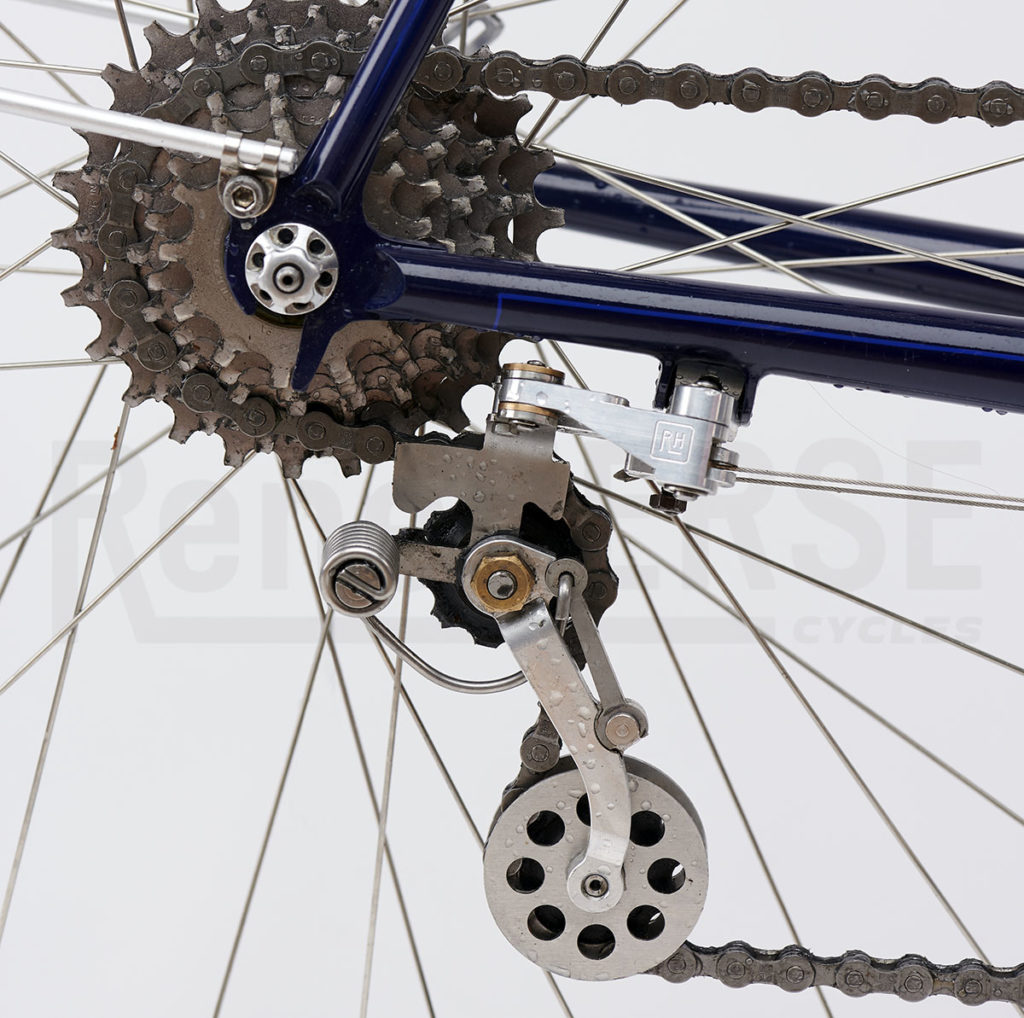
What makes the Nivex so special? First and foremost is the desmodromic operation. There’s no return spring, but two cables pull the derailleur in either direction. This means that the action is very light (no need to overcome the tension of the return spring) and immediate (no need to wait for the spring to move the derailleur after you release the cable). The derailleur cables run open, without cable housing, which reduces friction (and also makes the derailleur impervious to dirt).
There’s more to it – the spring that tensions the chain acts on a lever that moves with the derailleur cage in a carefully designed arc. This ensures that the chain tension is always the same, no matter which gear you’re in. There’s none of the chain slap you get with most derailleurs when riding in the small chainring and small-ish cogs on the rear. Many modern derailleurs have clutches to prevent the chain slap, but that adds weight and resistance to the shift. The Nivex system is more elegant. And since the chain tension is always light, the shifts are always the same. This consistency makes for very nice operation.
Beyond that, the Nivex has all the features of a modern derailleur, with a smoothly operating parallelogram that follows the contour of the freewheel, so the chain gap (distance from upper pulley to cassette cog) is always at the optimum value. In fact, Nivex was the first to introduce these features in 1938, and all modern derailleurs are direct descendants from this ground-breaking design – but they’ve lost some of the best features, the desmodromic operation and the constant chain tension. Combined, these features make for faster, lighter, and more consistent shifts than any other derailleur – classic or modern.
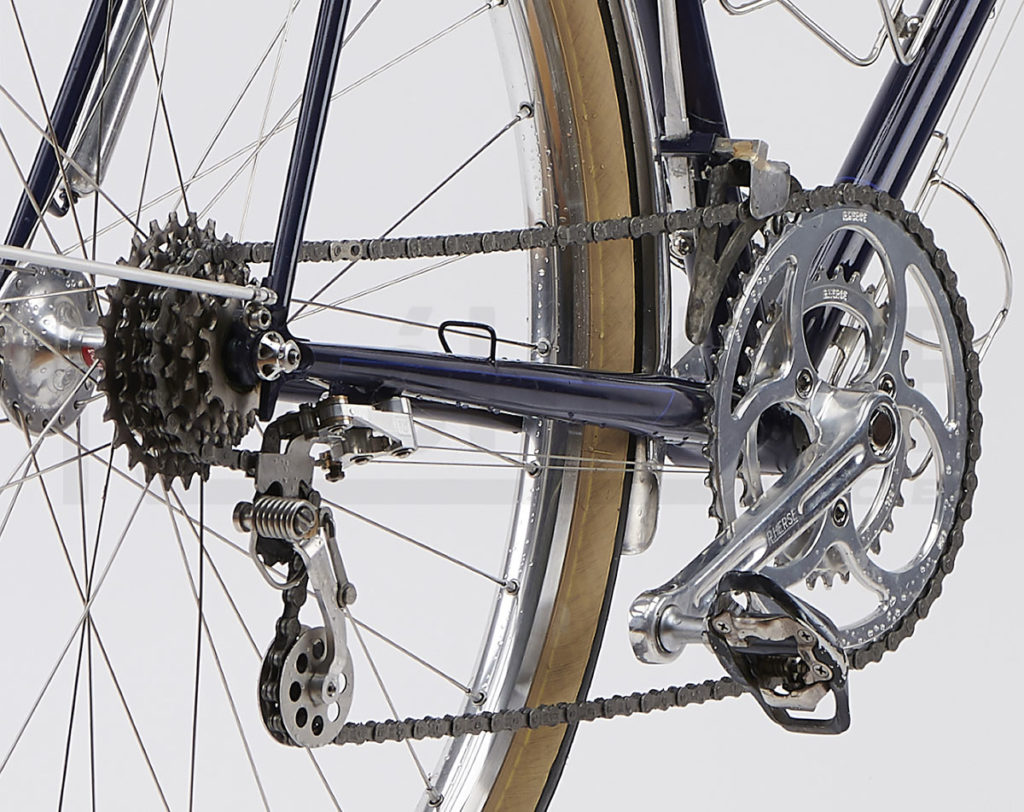
An added plus is the location under the chainstay, tucked inside the rear triangle. It’s well-protected there – even if the bike falls over, the derailleur won’t touch the ground. (On most bikes, the derailleur hits the ground first.)
When it came to building my new bike for the 2019 Paris-Brest-Paris, finding another mid-century Nivex wouldn’t do. I wanted new components – and at the same time, we figured we could improve on the original. So we gave it a slant parallelogram, optimized the arm lengths, and precision-machined it from aluminum and stainless steel. We made it 11-speed compatible and indexable. The last bit was quite easy, since its action is so light and consistent. We also managed to get the weight down to 178 g, which is competitive with today’s best derailleurs. (A Campagnolo Super Record mechanical rear derailleur weighs 181 g.)
It’s taken a few years to perfect the new derailleur. The Rene Herse Nivex isn’t intended as a novelty like those purple mountain bike derailleurs of the 1990s. Our goal is to offer a derailleur that surpasses the best from the ‘Big 3’ in function and durability. Like all our components, you’ll buy it because it works well and offers something you can’t get from the mainstream makers, not because it’s ‘cool’ or ‘retro.’ I’ve been riding the final production version for over a year now, and it’s proven totally trouble-free and shifts as well as it did the day I put it on my bike. On another bike, we’ve been running the indexed 11-speed version… And if any part ever wears out, the new Nivex is fully rebuildable. The shifter cable is a standard tandem cable. Since the shifting action is so light, there’s little strain on the cable, and the cable is unlikely to fray and need replacement. If it happens anyhow, you can get a replacement at every good bike shop.
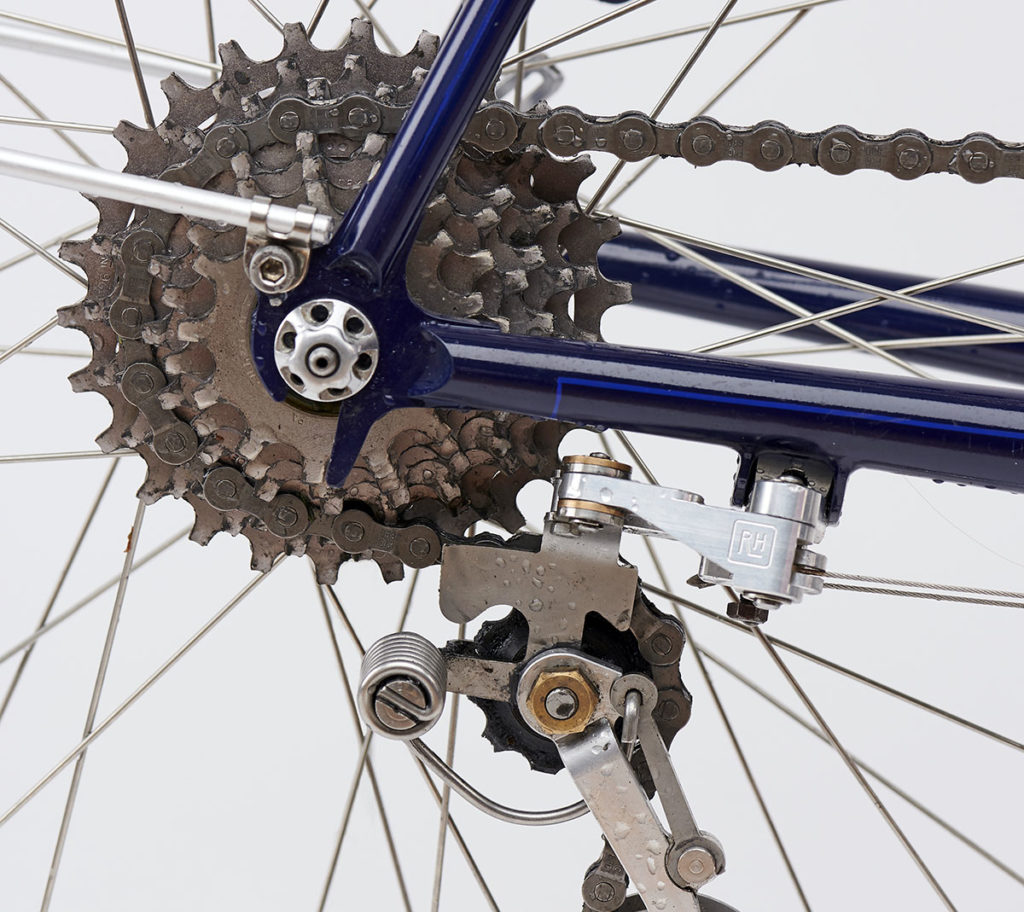
Drawbacks? With the derailleur mounted on the chainstay, removing and installing the rear wheel is a bit of a chore. The wheel can’t just drop downward since the chain wraps around the cassette on three sides. You have to take the chain off the cog by hand and tilt the wheel sideways to get it out, and reverse the process when you install it. The original Nivex had a chainrest – basically the last cog was part of the dropout and smooth (since it doesn’t turn). You shift onto the chainrest, and then you remove the wheel without touching the chain. My 2011 Herse has that feature. (It also allows you to shift onto the chainrest during long mountain descents and coast in silence.) The downside is that you lose one cog. Since I have so few flats, I decided to forego that feature on my new bike and get an extra gear instead.
Another issue, depending on your preferences: Since the position of the upper pulley is fixed, the derailleur doesn’t work with extreme gear ranges. We designed it so it can handle up to a 12-30 rear cassette – plenty for my taste, but if you need a bigger spread of gears, the Nivex won’t work. It also takes some skill to set up, since there is no return spring to take up the slack. We’ll offer a cable tensioner that makes it easy to dial in the cable tension and get the indexing just right.
This brings up the question many have asked: When will the Rene Herse Nivex be available? The derailleurs are in production right now, but there are many small parts, and some are taking longer than others, especially with the current situation in the bike industry. There will also be special dropouts – since there is no derailleur behind the dropouts, the slots can angle a bit to the rear, so they line up with the fenders, making the wheel easier to remove and install. There’s also a tool to locate the braze-on. (You can retrofit any steel frame simply by brazing on the derailleur hanger onto the chainstay, plus a guide for the two cables under the bottom bracket.)
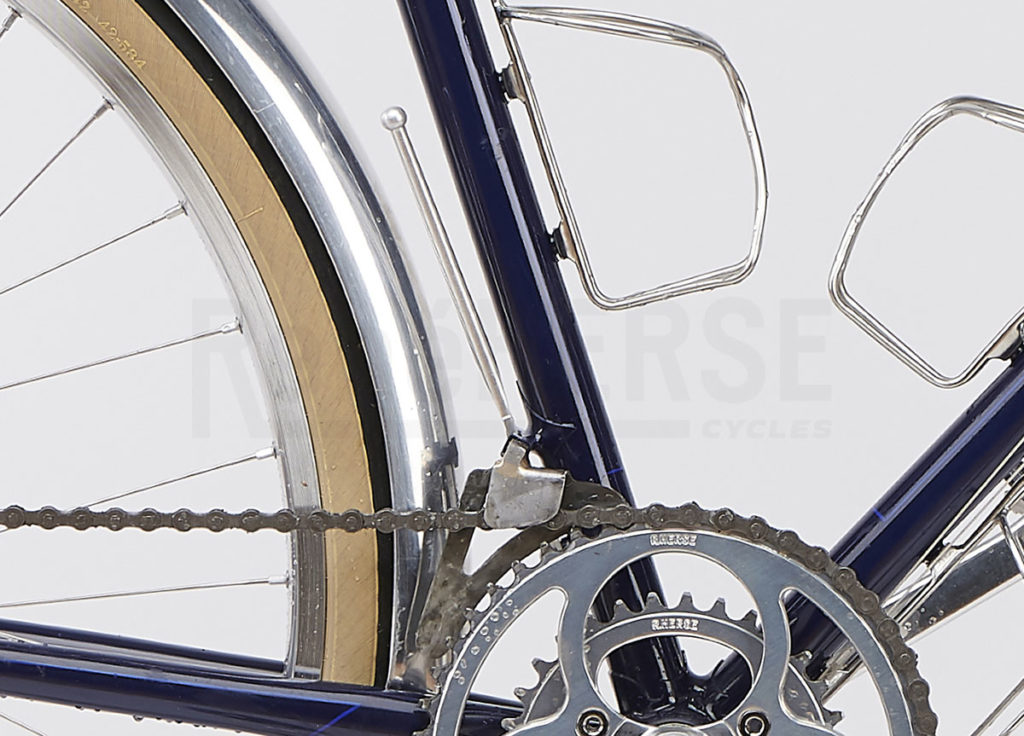
What about the front derailleur? It’s a replica of a 1940s Rene Herse derailleur. (When we photographed the bike at the start of Paris-Brest-Paris, the derailleur wasn’t chrome-plated yet.) This derailleur doesn’t use a cable at all – you push the lever and the chain moves to the next chainring. Some people call them ‘suicide’ derailleurs, but shifting with a lever-operated front derailleur isn’t any more difficult than retrieving a water bottle from the cage on the seat tube. Nobody talks about ‘suicide bottle cages.’
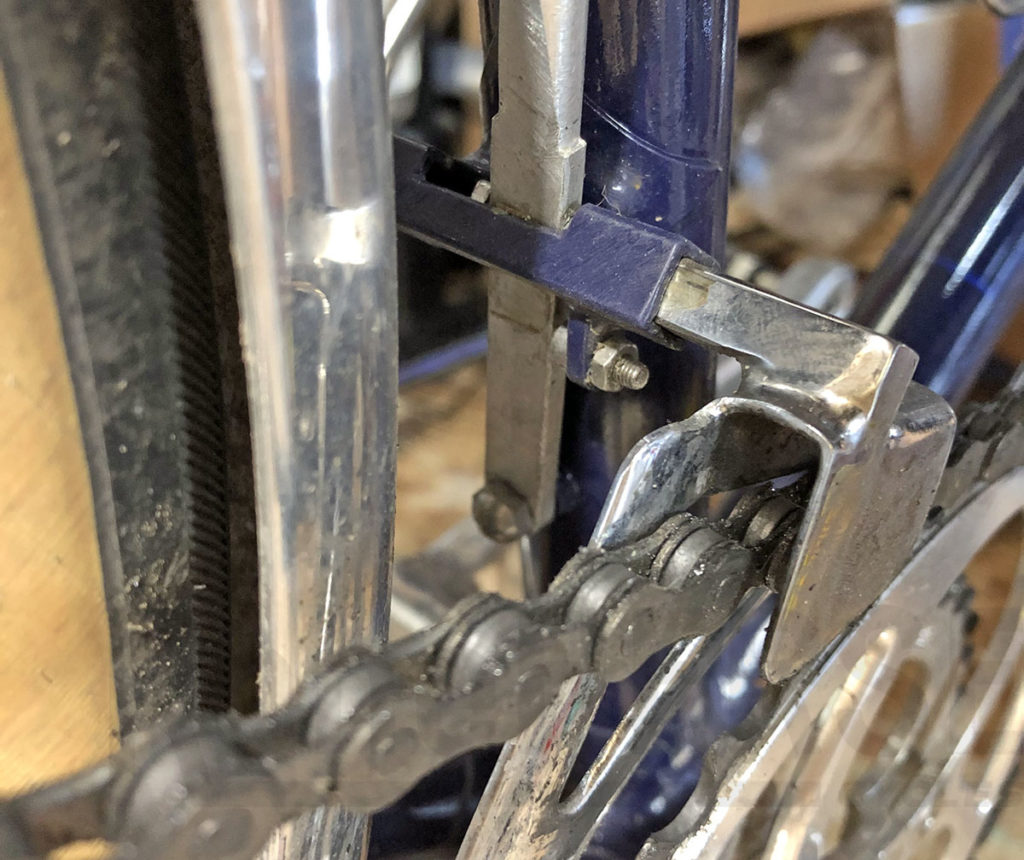
It sounds crude at first – there isn’t even a parallelogram, just a simple lever that pushes the derailleur cage from side to side. But since the derailleur is very stiff and you control it directly, shifts are fast and positive. The shift quality resembles that of a modern electronic derailleur, where the motor pushes the chain with great force. It’s also very light – 64 g – and you save further weight because there’s no shift lever, no cable and no housing. The derailleur is free to float over the chain, so you don’t need to trim it when you shift on the rear. If the chain rubs, the derailleur just moves until it’s centered again.
For this bike, I’ve incorporated a limit screw. On the original, the length of the slot determined how far the derailleur moved, but if your crank seats a bit further on the spindle after many years, the derailleur can move too far and throw the chain to the outside. There’s no need for an inner limit screw. When you shift onto the small ring, the derailleur moves all the way inward, so it clears the chain with ample room. In all those miles, I’ve never dropped the chain to the inside, and nor have the other riders who’ve tried my bike. I guess it would be possible if I hit the lever with great force…
Shifts do take a bit more ‘gymnastics’ than just pushing a button on the brake lever. On a long ride like Paris-Brest-Paris, that’s a good thing, as it stretches my back and relieves the pressure on my hands. In any case, I don’t shift all that often on the front, as my ‘big’ ring is small enough to use almost all the time, with the small ring only for really steep hills – sort of like ‘one-by plus granny.’
Will we offer the front derailleur in the future, too? I’m not sure. It’s quite difficult to make in small numbers – shaping the cage out of CrMo steel takes time and skill, but more importantly, locating the square tube on the seatstay requires precision. We filed the slot to its final length after the square tube was brazed on, and then we brazed the derailleur cage to its support while it was mounted on the frame. I’m sure René Herse in the old days had a fixture to make this more efficient, since they made hundreds of these a year. Maybe we’ll offer a kit for framebuilders at some point…
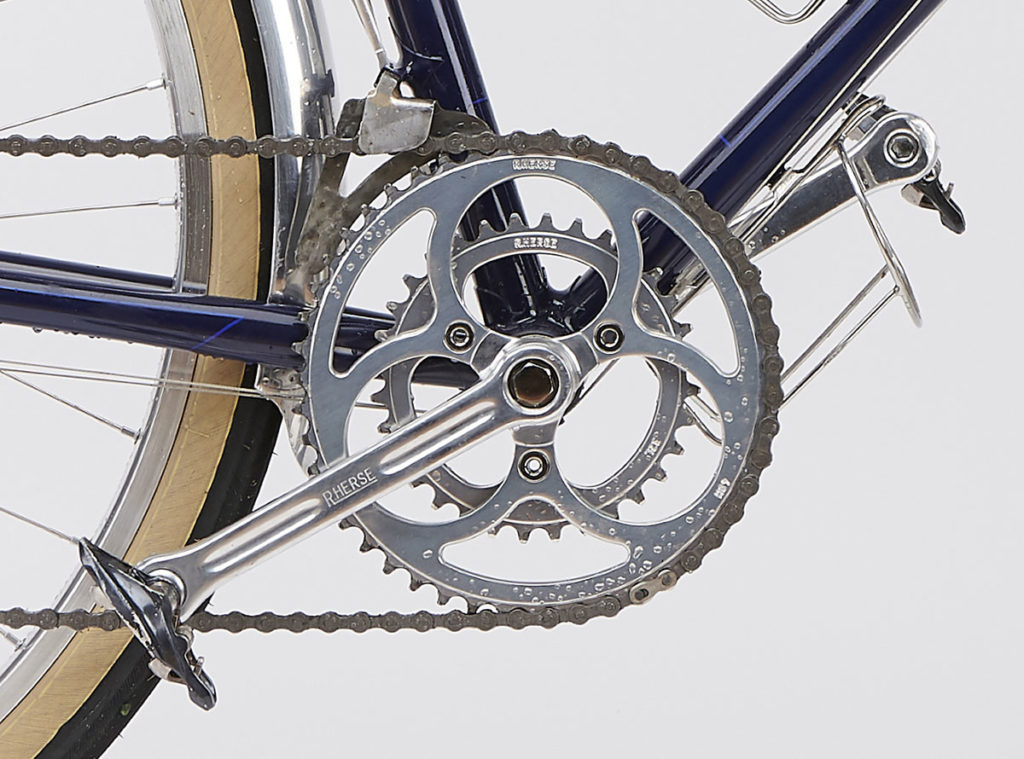
Since we’re talking about the drivetrain, it makes sense to cover the cranks in this post, too. There isn’t much that I haven’t said about our Rene Herse cranks. Thanks to net-shape forging and the efficient 3-arm design, they are superlight, yet they pass the highest EN Racing Bike test for fatigue resistance. (No other ’boutique’ cranks meet this standard.) They offer a low Q factor and almost unlimited choice of chainrings. For Paris-Brest-Paris, I run a 48×32 combination. Here in the Cascade Mountains, I often put on 46×30 rings to get slightly smaller gears for the long gravel climbs. (Changing the rings is easy and doesn’t require removing the cranks, nor the pedals.)
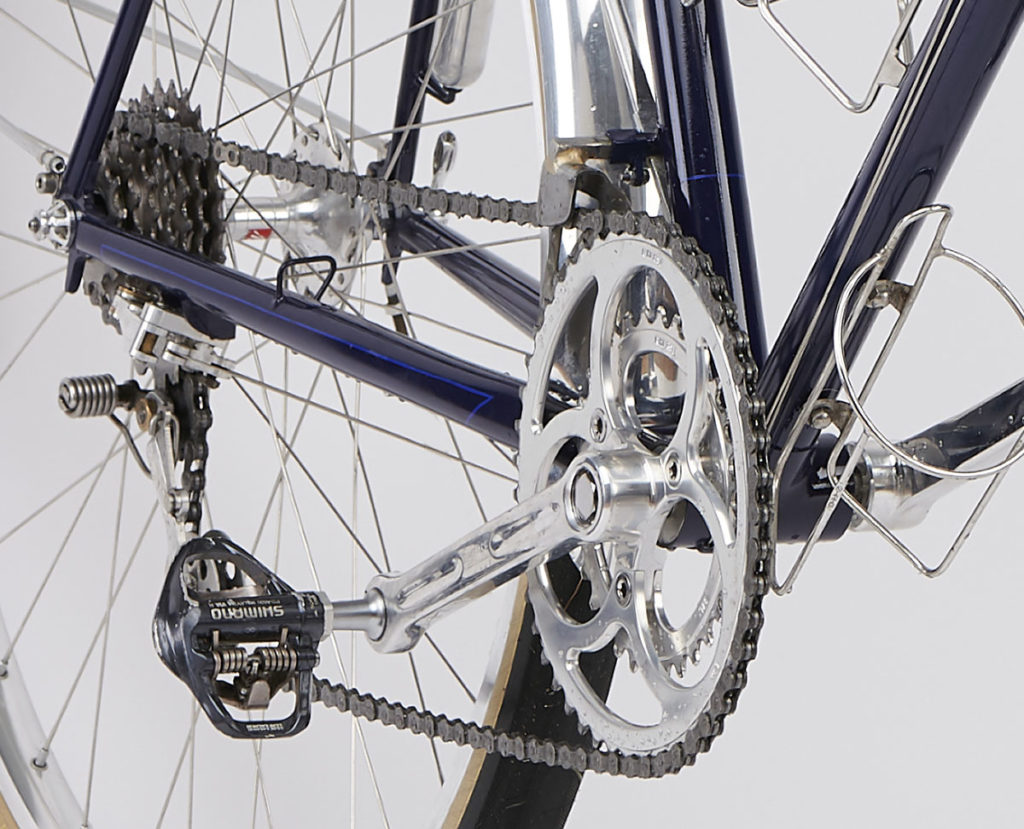
So that’s the story of the derailleurs on my bike. It’s not that modern derailleurs aren’t any good; it’s just that they were designed for different criteria than what’s important to me. I don’t need to shift under load – although the Nivex does this better than almost any classic derailleur – but I do want immediate, positive shifts. I like a ‘manual’ bike where it’s me and not a servo motor who’s moving the chain.
Here’s an old video showing the front derailleur in action on my 2011 bike.
Other parts in this series:
- My PBP bike: the frame
- My PBP bike: the wheels
- My PBP bike: contact points
- Why I choose centerpull brakes
- My PBP bike: fenders
- My PBP bike: rack and bag
- My PBP bike: lights
Photo credits: Nicolas Joly (all except Photos 3 and 7).


